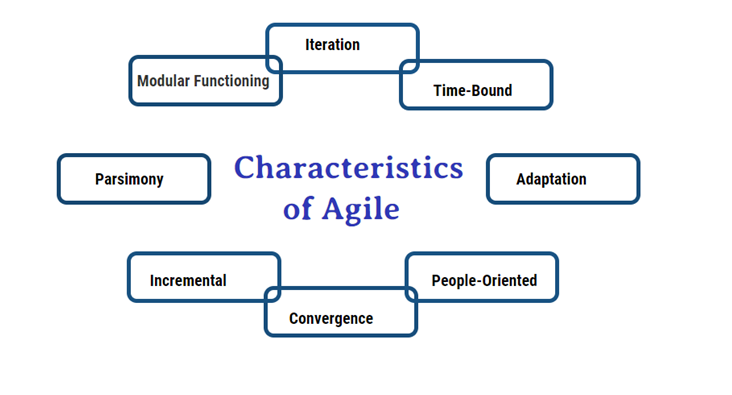Agile Characteristics

Characteristics of Agile Methodology in Software development -
- Iterative and Incremental Development - Agile breaks down the development process into smaller,
manageable chunks called iterations or sprints, typically lasting 1–4 weeks.
Each sprint results in a usable product increment, allowing for regular feedback and adjustments.
This approach enables teams to adapt to changes quickly and deliver value continuously.
Example: Imagine building a house room by room. After completing each room, you invite the homeowner to review and suggest changes, ensuring the final house meets their expectations. - Flexibility and Agility - Agile embraces change, even late in the development process.
Requirements can evolve based on customer feedback, market shifts, or new insights.
This flexibility ensures the final product remains relevant and valuable.
Example: Consider a restaurant updating its menu based on customer preferences and seasonal ingredients, ensuring diners always have appealing options. - Early Identification and Issue Resolution - By delivering work in small increments and involving stakeholders throughout the process,
Agile teams can identify and address issues early.
This proactive approach reduces the risk of major problems later on.
Example: Think of a student regularly reviewing their coursework with a tutor, catching misunderstandings early and improving their performance over time. - Continuous Communication and Collaboration - Agile emphasizes regular communication among team members and stakeholders.
Daily stand-up meetings, sprint reviews, and retrospectives foster transparency and collective ownership.
Example: A sports team huddling before each play to discuss strategy ensures everyone is aligned and can adapt quickly during the game. - Enhanced Team Morale and Enjoyment - Agile promotes a collaborative and empowering environment.
Teams have autonomy, make decisions collectively, and focus on delivering value, leading to increased job satisfaction and motivation.
Example: Employees in a company that encourages innovation and values input from all levels often feel more engaged and committed to their work. - Transparency - Agile provides visibility into the development process for all stakeholders.
Progress is tracked openly, and stakeholders can review work at any stage, fostering trust and informed decision-making.
Example: A classroom where students' progress is displayed on a board allows teachers and parents to monitor and support learning effectively. - Early and Predictable Delivery - Time-boxed sprints enable teams to deliver functional product increments regularly.
This predictability allows stakeholders to plan releases and gather user feedback early, enhancing the product's alignment with user needs.
Example: A bakery introducing new pastries weekly based on customer preferences can quickly identify bestsellers and adjust offerings accordingly. - Predictable Costs and Schedule - Fixed-duration sprints and defined scopes allow for accurate cost and time estimations.
Stakeholders can make informed decisions about feature prioritization and budgeting.
Example: Planning a trip with a set budget and itinerary helps travelers manage expenses and time effectively. - Iterative and Evolving Requirements - Agile acknowledges that not all requirements are known upfront.
Through iterative development and continuous feedback, the product evolves to meet emerging needs and market changes.
Example: A smartphone app that updates regularly based on user feedback ensures it stays relevant and user-friendly.
